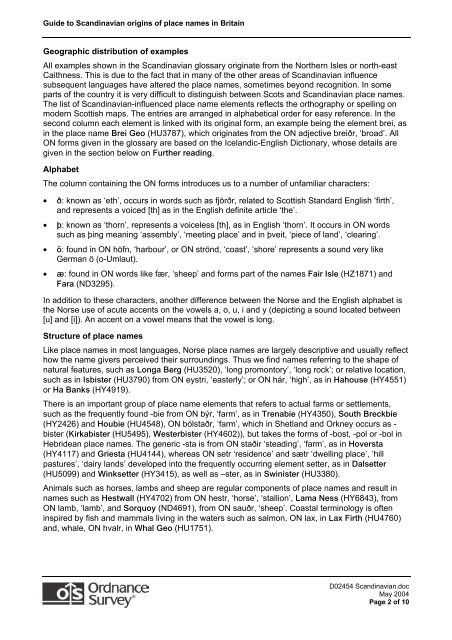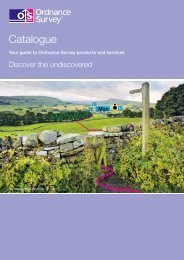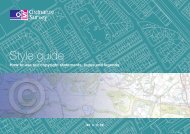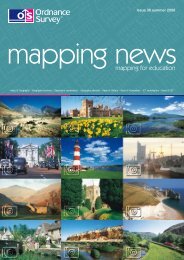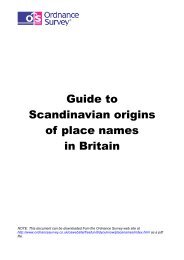Guide to Scandinavian origins of place names in ... - Ordnance Survey
Guide to Scandinavian origins of place names in ... - Ordnance Survey
Guide to Scandinavian origins of place names in ... - Ordnance Survey
Create successful ePaper yourself
Turn your PDF publications into a flip-book with our unique Google optimized e-Paper software.
<strong>Guide</strong> <strong>to</strong> <strong>Scand<strong>in</strong>avian</strong> <strong>orig<strong>in</strong>s</strong> <strong>of</strong> <strong>place</strong> <strong>names</strong> <strong>in</strong> Brita<strong>in</strong><br />
Geographic distribution <strong>of</strong> examples<br />
All examples shown <strong>in</strong> the <strong>Scand<strong>in</strong>avian</strong> glossary orig<strong>in</strong>ate from the Northern Isles or north-east<br />
Caithness. This is due <strong>to</strong> the fact that <strong>in</strong> many <strong>of</strong> the other areas <strong>of</strong> <strong>Scand<strong>in</strong>avian</strong> <strong>in</strong>fluence<br />
subsequent languages have altered the <strong>place</strong> <strong>names</strong>, sometimes beyond recognition. In some<br />
parts <strong>of</strong> the country it is very difficult <strong>to</strong> dist<strong>in</strong>guish between Scots and <strong>Scand<strong>in</strong>avian</strong> <strong>place</strong> <strong>names</strong>.<br />
The list <strong>of</strong> <strong>Scand<strong>in</strong>avian</strong>-<strong>in</strong>fluenced <strong>place</strong> name elements reflects the orthography or spell<strong>in</strong>g on<br />
modern Scottish maps. The entries are arranged <strong>in</strong> alphabetical order for easy reference. In the<br />
second column each element is l<strong>in</strong>ked with its orig<strong>in</strong>al form, an example be<strong>in</strong>g the element brei, as<br />
<strong>in</strong> the <strong>place</strong> name Brei Geo (HU3787), which orig<strong>in</strong>ates from the ON adjective breiðr, ‘broad’. All<br />
ON forms given <strong>in</strong> the glossary are based on the Icelandic-English Dictionary, whose details are<br />
given <strong>in</strong> the section below on Further read<strong>in</strong>g.<br />
Alphabet<br />
The column conta<strong>in</strong><strong>in</strong>g the ON forms <strong>in</strong>troduces us <strong>to</strong> a number <strong>of</strong> unfamiliar characters:<br />
• ð: known as ‘eth’, occurs <strong>in</strong> words such as fjörðr, related <strong>to</strong> Scottish Standard English ‘firth’,<br />
and represents a voiced [th] as <strong>in</strong> the English def<strong>in</strong>ite article ‘the’.<br />
• þ: known as ‘thorn’, represents a voiceless [th], as <strong>in</strong> English ‘thorn’. It occurs <strong>in</strong> ON words<br />
such as þ<strong>in</strong>g mean<strong>in</strong>g ‘assembly’, ‘meet<strong>in</strong>g <strong>place</strong>’ and <strong>in</strong> þveit, ‘piece <strong>of</strong> land’, ‘clear<strong>in</strong>g’.<br />
• ö: found <strong>in</strong> ON höfn, ‘harbour’, or ON strönd, ‘coast’, ‘shore’ represents a sound very like<br />
German ö (o-Umlaut).<br />
• æ: found <strong>in</strong> ON words like fær, ‘sheep’ and forms part <strong>of</strong> the <strong>names</strong> Fair Isle (HZ1871) and<br />
Fara (ND3295).<br />
In addition <strong>to</strong> these characters, another difference between the Norse and the English alphabet is<br />
the Norse use <strong>of</strong> acute accents on the vowels a, o, u, i and y (depict<strong>in</strong>g a sound located between<br />
[u] and [i]). An accent on a vowel means that the vowel is long.<br />
Structure <strong>of</strong> <strong>place</strong> <strong>names</strong><br />
Like <strong>place</strong> <strong>names</strong> <strong>in</strong> most languages, Norse <strong>place</strong> <strong>names</strong> are largely descriptive and usually reflect<br />
how the name givers perceived their surround<strong>in</strong>gs. Thus we f<strong>in</strong>d <strong>names</strong> referr<strong>in</strong>g <strong>to</strong> the shape <strong>of</strong><br />
natural features, such as Longa Berg (HU3520), ‘long promon<strong>to</strong>ry’, ‘long rock’; or relative location,<br />
such as <strong>in</strong> Isbister (HU3790) from ON eystri, ‘easterly’; or ON hár, ‘high’, as <strong>in</strong> Hahouse (HY4551)<br />
or Ha Banks (HY4919).<br />
There is an important group <strong>of</strong> <strong>place</strong> name elements that refers <strong>to</strong> actual farms or settlements,<br />
such as the frequently found -bie from ON býr, ‘farm’, as <strong>in</strong> Trenabie (HY4350), South Breckbie<br />
(HY2426) and Houbie (HU4548), ON bólstaðr, ‘farm’, which <strong>in</strong> Shetland and Orkney occurs as -<br />
bister (Kirkabister (HU5495), Westerbister (HY4602)), but takes the forms <strong>of</strong> -bost, -pol or -bol <strong>in</strong><br />
Hebridean <strong>place</strong> <strong>names</strong>. The generic -sta is from ON staðir ‘stead<strong>in</strong>g’, ‘farm’, as <strong>in</strong> Hoversta<br />
(HY4117) and Griesta (HU4144), whereas ON setr ‘residence’ and sætr ‘dwell<strong>in</strong>g <strong>place</strong>’, ‘hill<br />
pastures’, ‘dairy lands’ developed <strong>in</strong><strong>to</strong> the frequently occurr<strong>in</strong>g element setter, as <strong>in</strong> Dalsetter<br />
(HU5099) and W<strong>in</strong>ksetter (HY3415), as well as –ster, as <strong>in</strong> Sw<strong>in</strong>ister (HU3380).<br />
Animals such as horses, lambs and sheep are regular components <strong>of</strong> <strong>place</strong> <strong>names</strong> and result <strong>in</strong><br />
<strong>names</strong> such as Hestwall (HY4702) from ON hestr, ‘horse’, ‘stallion’, Lama Ness (HY6843), from<br />
ON lamb, ‘lamb’, and Sorquoy (ND4691), from ON sauðr, ‘sheep’. Coastal term<strong>in</strong>ology is <strong>of</strong>ten<br />
<strong>in</strong>spired by fish and mammals liv<strong>in</strong>g <strong>in</strong> the waters such as salmon, ON lax, <strong>in</strong> Lax Firth (HU4760)<br />
and, whale, ON hvalr, <strong>in</strong> Whal Geo (HU1751).<br />
D02454 <strong>Scand<strong>in</strong>avian</strong>.doc<br />
May 2004<br />
Page 2 <strong>of</strong> 10


